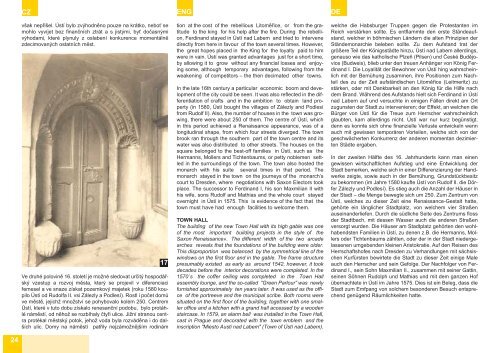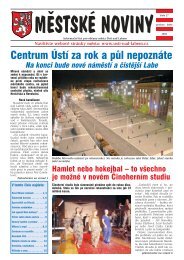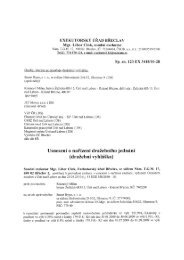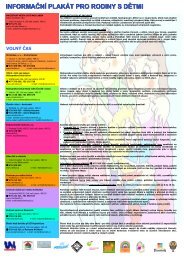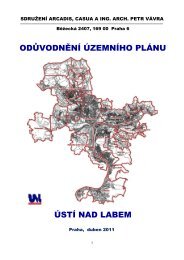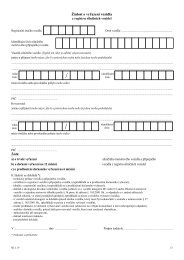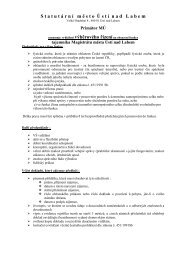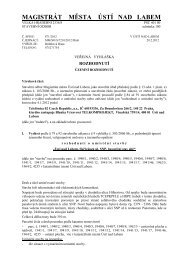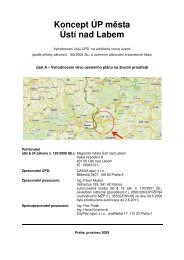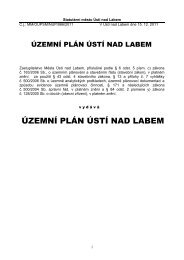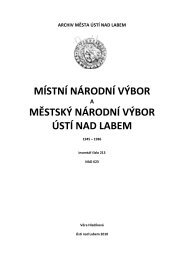Historie a památky města Ústí nad Labem History and monuments of ...
Historie a památky města Ústí nad Labem History and monuments of ...
Historie a památky města Ústí nad Labem History and monuments of ...
Sie wollen auch ein ePaper? Erhöhen Sie die Reichweite Ihrer Titel.
YUMPU macht aus Druck-PDFs automatisch weboptimierte ePaper, die Google liebt.
24<br />
CZ ENG DE<br />
však nepřišel. <strong>Ústí</strong> bylo zvýhodněno pouze na krátko, neboť se<br />
mohlo vyvíjet bez finančních ztrát a s jistými, byť dočasnými<br />
výhodami, které plynuly z oslabení konkurence momentálně<br />
zdecimovaných ostatních měst.<br />
17<br />
Ve druhé polovině 16. století je možné sledovat určitý hospodářský<br />
vzestup a rozvoj <strong>města</strong>, který se projevil v diferenciaci<br />
řemesel a ve snaze získat pozemkový majetek (roku 1580 koupilo<br />
<strong>Ústí</strong> od Rudolfa II. vsi Zálezly a Podlesí). Rostl i počet domů<br />
ve městě, jejichž množství se pohybovalo kolem 250. Centrem<br />
<strong>Ústí</strong>, které v tuto dobu získalo renesanční podobu, bylo protáhlé<br />
náměstí, od něhož se rozbíhaly čtyři ulice. Jižní stranou centra<br />
protékal městský potok, jehož voda byla rozváděna i do dalších<br />
ulic. Domy na náměstí patřily nejzámožnějším rodinám<br />
tion at the cost <strong>of</strong> the rebellious Litoměřice, or from the gratitude<br />
to the king for his help after the fire. During the rebellion,<br />
Ferdin<strong>and</strong> stayed in <strong>Ústí</strong> <strong>nad</strong> <strong>Labem</strong> <strong>and</strong> tried to intervene<br />
directly from here in favour <strong>of</strong> the town several times. However,<br />
the great hopes placed in the King for the loyalty paid to him<br />
were in vain. <strong>Ústí</strong> was granted advantages just for a short time,<br />
by allowing it to grow without any financial losses <strong>and</strong> enjoying<br />
some, although temporary advantages, following from the<br />
weakening <strong>of</strong> competitors – the then decimated other towns.<br />
In the late 16th century a particular economic boom <strong>and</strong> development<br />
<strong>of</strong> the city could be seen. It was also reflected in the differentiation<br />
<strong>of</strong> crafts <strong>and</strong> in the ambition to obtain l<strong>and</strong> property<br />
(in 1580, <strong>Ústí</strong> bought the villages <strong>of</strong> Zálezly <strong>and</strong> Podlesí<br />
from Rudolf II). Also, the number <strong>of</strong> houses in the town was growing,<br />
there were about 250 <strong>of</strong> them. The centre <strong>of</strong> <strong>Ústí</strong>, which<br />
in this period achieved a Renaissance appearance, was <strong>of</strong> a<br />
longitudinal shape, from which four streets diverged. The town<br />
brook ran through the southern part <strong>of</strong> the town centre <strong>and</strong> its<br />
water was also distributed to other streets. The houses on the<br />
square belonged to the best-<strong>of</strong>f families in <strong>Ústí</strong>, such as the<br />
Hermanns, Mollers <strong>and</strong> Tichtenbaums, or petty noblemen settled<br />
in the surroundings <strong>of</strong> the town. The town also hosted the<br />
monarch with his suite several times in that period. The<br />
monarch stayed in the town on the journeys <strong>of</strong> the monarch’s<br />
court to Dresden, where negotiations with Saxon Electors took<br />
place. The successor to Ferdin<strong>and</strong> I, his son Maxmilian II with<br />
his wife, sons Rudolf <strong>and</strong> Mathias <strong>and</strong> the whole court stayed<br />
overnight in <strong>Ústí</strong> in 1575. This is evidence <strong>of</strong> the fact that the<br />
town must have had enough facilities to welcome them.<br />
TOWN HALL<br />
The building <strong>of</strong> the new Town Hall with its high gable was one<br />
<strong>of</strong> the most important building projects in the style <strong>of</strong> the<br />
Saxon Renaissance». The different width <strong>of</strong> the two arcade<br />
arches reveals that the foundations <strong>of</strong> the building were older.<br />
This disproportion was balanced by the symmetrical line <strong>of</strong> the<br />
windows on the first floor <strong>and</strong> in the gable. The frame structure<br />
presumably existed as early as around 1542, however, it took<br />
decades before the interior decorations were completed. In the<br />
1570´s the c<strong>of</strong>fer ceiling was completed in the Town Hall<br />
assembly lounge, <strong>and</strong> the so-called “Green Parlour” was newly<br />
furnished approximately ten years later. It was used as the <strong>of</strong>fice<br />
<strong>of</strong> the portreeve <strong>and</strong> the municipal scribe. Both rooms were<br />
situated on the first floor <strong>of</strong> the building, together with one smaller<br />
<strong>of</strong>fice <strong>and</strong> a kitchen with a gr<strong>and</strong> hall accessed by a wooden<br />
staircase. In 1579, an alarm bell was installed in the Town Hall,<br />
cast in Prague <strong>and</strong> decorated with the town emblem <strong>and</strong> the<br />
inscription "Miesto Austi <strong>nad</strong> <strong>Labem</strong>" (Town <strong>of</strong> <strong>Ústí</strong> <strong>nad</strong> <strong>Labem</strong>).<br />
welche die Habsburger Truppen gegen die Protestanten im<br />
Reich verstärken sollte. Es entflammte den erste Ständeaufst<strong>and</strong>,<br />
welcher in böhmischen Ländern die alten Prinzipien der<br />
Ständemonarchie beleben sollte. Zu dem Aufst<strong>and</strong> trat der<br />
größere Teil der Königsstädte hinzu, <strong>Ústí</strong> <strong>nad</strong> <strong>Labem</strong> allerdings,<br />
genauso wie das katholische Plzeň (Pilsen) und České Budějovice<br />
(Budweis), blieb unter den treuen Anhänger von König Ferdin<strong>and</strong><br />
I. Die Loyalität der Bewohner von <strong>Ústí</strong> hing wahrscheinlich<br />
mit der Bemühung zusammen, ihre Positionen zum Nachteil<br />
des zu der Zeit aufständischen Litoměřice (Leitmeritz) zu<br />
stärken, oder mit Dankbarkeit an den König für die Hilfe nach<br />
dem Br<strong>and</strong>. Während des Aufst<strong>and</strong>s hielt sich Ferdin<strong>and</strong> in <strong>Ústí</strong><br />
<strong>nad</strong> <strong>Labem</strong> auf und versuchte in einigen Fällen direkt am Ort<br />
zugunsten der Stadt zu intervenieren; der Effekt, an welchen die<br />
Bürger von <strong>Ústí</strong> für die Treue zum Herrscher wahrscheinlich<br />
glaubten, kam allerdings nicht. <strong>Ústí</strong> war nur kurz begünstigt,<br />
denn es konnte sich ohne finanzielle Verluste entwickeln wenn<br />
auch mit gewissen temporären Vorteilen, welche sich von der<br />
geschwächerten Konkurrenz der <strong>and</strong>eren momentan dezimierten<br />
Städte ergaben.<br />
In der zweiten Hälfte des 16. Jahrhunderts kann man einen<br />
gewissen wirtschaftlichen Aufstieg und eine Entwicklung der<br />
Stadt bemerken, welche sich in einer Differenzierung der H<strong>and</strong>werke<br />
zeigte, sowie auch in der Bemühung, Grundstückbesitz<br />
zu bekommen (im Jahre 1580 kaufte <strong>Ústí</strong> von Rudolf II. die Dörfer<br />
Zálezly und Podlesí). Es stieg auch die Anzahl der Häuser in<br />
der Stadt – die Menge bewegte sich um 250. Zum Zentrum von<br />
<strong>Ústí</strong>, welches zu dieser Zeit eine Renaissance-Gestalt hatte,<br />
gehörte ein länglicher Stadtplatz, von welchem vier Straßen<br />
ausein<strong>and</strong>erliefen. Durch die südliche Seite des Zentrums floss<br />
der Stadtbach, mit dessen Wasser auch die <strong>and</strong>eren Straßen<br />
versorgt wurden. Die Häuser am Stadtplatz gehörten den wohlhabendsten<br />
Familien in <strong>Ústí</strong>, zu denen z.B. die Hermanns, Mollers<br />
oder Tichtenbaums zählten, oder der in der Stadt niedergelassenen<br />
umgebenden kleinen Aristokratie. Auf den Reisen des<br />
Herrschaftsh<strong>of</strong>es nach Dresden zu Verh<strong>and</strong>lungen mit sächsischen<br />
Kurfürsten bewirtete die Stadt zu dieser Zeit einige Male<br />
auch den Herrscher und sein Gefolge. Der Nachfolger von Ferdin<strong>and</strong><br />
I., sein Sohn Maxmilian II., zusammen mit seiner Gattin,<br />
seinen Söhnen Rudolph und Mathias und mit dem ganzen H<strong>of</strong><br />
übernachtete in <strong>Ústí</strong> im Jahre 1575. Dies ist ein Beleg, dass die<br />
Stadt zum Emfpang von solchem besonderen Besuch entsprechend<br />
genügend Räumlichkeiten hatte.


